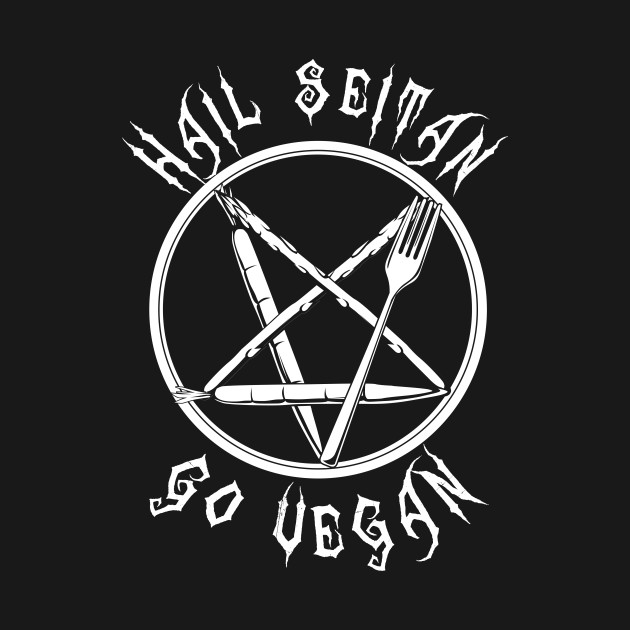The wonder of wheat meat
When people overhear groups of vegans enthusiastically discussing seitan (pronounced say-tan), they could be forgiven for thinking that they’re part of some bizarre satanic cult that forbids the use of any animal products. But it’s seitan, not satan that vegans are interested in. That’s not to say there definitely aren’t any Satanists that are also ‘seitan-ists’, and if you know of anyone fitting that description then we’d love to hear from you! Seitan – also known as ‘wheat meat’, ‘wheat gluten’, ‘wheat protein’, or just ‘gluten’ – is a wheat-based vegan meat substitute that is extremely high in protein. Although it’s made from wheat, it’s really nothing like bread, especially in terms of consistency – but vital wheat gluten flour is sometimes used in bread making to give loaves an extra chewy and firm texture.
It was invented in China centuries ago, where it was developed primarily for Buddhists who chose not to eat animals and would have seitan in place of meat in all sorts of dishes. The Chinese name for it is ‘mien chin’ which literally translates to ‘dough tendon’ – a good indication of how well seitan mimics the texture of meat. Popular in plenty of Asian countries for hundreds of years, seitan wasn’t properly introduced to the west until 1969 when a company called Erewhon imported it to the United States. Now it’s widely available in the UK and Europe in various forms, largely thanks to the ever-increasing popularity of plant-based diets. You’ll find it in lots of Asian restaurants and buffets today, often simply called ‘gluten’, served in a variety of ways including cold with dishes of fresh vegetables, and hot spicy beef style curries. Seitan makes a fantastic mock duck, so it’s commonly eaten in savoury pancakes with a hoisin sauce and spring onions.

Cooked Seitan
If you’re vegan, chances are you’ve been asked “where do you get your protein?” by a concerned or indignant meat-eater. That question is usually informed by the assumption that meat and animal products are far higher in protein than anything the vegan diet can offer, so it may surprise people to hear that seitan typically contains 75g of protein per 100g. To put that in perspective, beef usually contains a mere 26g of protein per 100g, meaning ‘wheat meat’ offers almost three times the amount of protein! Not only is it incredibly high in protein and a great source of iron, the fat content of seitan is staggeringly low too, meaning it scores big on the nutrition front as well as being the compassionate choice for anyone craving meaty texture and flavour.
Seitan Nutrition Facts (per 100g)
- Calories: 370
- Calories from fat: 17
- Total Fat (grams):
- Cholesterol (milligrams): 0
- Carbohydrate (grams): 14
- Protein (grams): 75
- Calcium: 14% RDA
- Iron: 29% RDA

Vital Wheat Gluten Flour

Seitan dough (pre-cooking)
Seitan is made from gluten, the main protein found in wheat. You can buy ‘vital wheat gluten’ to make your own seitan, or you can wash the starch out of wheat flour until you are left with only the elastic gluten dough. The process of washing out the starch yourself can be fairly labour-intensive and time-consuming, but thankfully vital wheat gluten flour is widely available and is ready to be mixed with water or broth to make mock meat.
Seitan also comes pre-made in all sorts of styles and flavours, from smoked steaks to tinned mock duck, and can be found in most health food shops and Asian supermarkets. This abundance of ready-to-eat gluten-based mock meats is great news for vegans, but the bonus of making your own seitan is that you can flavour it with whatever you like and choose how you prepare and cook it to get the desired texture. It can be simmered in a flavoured broth, steamed, baked, roasted, and even deep-fried. Once cooked, it can be used as a perfect meat substitute in an endless array of dishes, from BBQ ‘ribs’ to mock roast chicken cutlets.
Part of the appeal of seitan is that it is extremely versatile. Different recipes and cooking methods can achieve the whole gamut of textures – from soft dumplings and meatloaf to crispy bacon and chewy jerky. And the possibilities are practically endless when it comes to flavour. Mixing the vital wheat gluten flour with a broth or liquid stock and combinations of herbs, spices, seasonings, and big flavours like garlic granules and liquid smoke means you can create seitan that goes beyond a mere meat substitute.
If you want to try seitan for yourself, then ask your local health food or whole food shop if they stock ‘Vital Wheat Gluten Flour’. Chances are they already do, and if they don’t they’ll more than likely be able to order some in for you. It’s also really easy and cheap to buy over the internet from a number of online retailers. Basic seitan involves adding liquid to the flour to make a dough, and kneading before cooking to achieve different textures. There are loads of recipes to try in various vegan cookbooks and food blogs, and after a few seitan outings, you’ll be confident enough to start attempting your own concoctions.
If you’ve got a brilliant seitan recipe that you think we need to try then we want to hear about it! Share a picture and a recipe on our facebook, twitter, or by tagging us in a post on instagram.
Welcome to the cult, and hail seitan!
Image: veganyumyum.com – check out the recipe for Tamarind Seitan Kabobs on the next page
Taken from June 2015 (Issue 6) Vegan Life Magazine
The post Hail Seitan! appeared first on Vegan Life Magazine.
